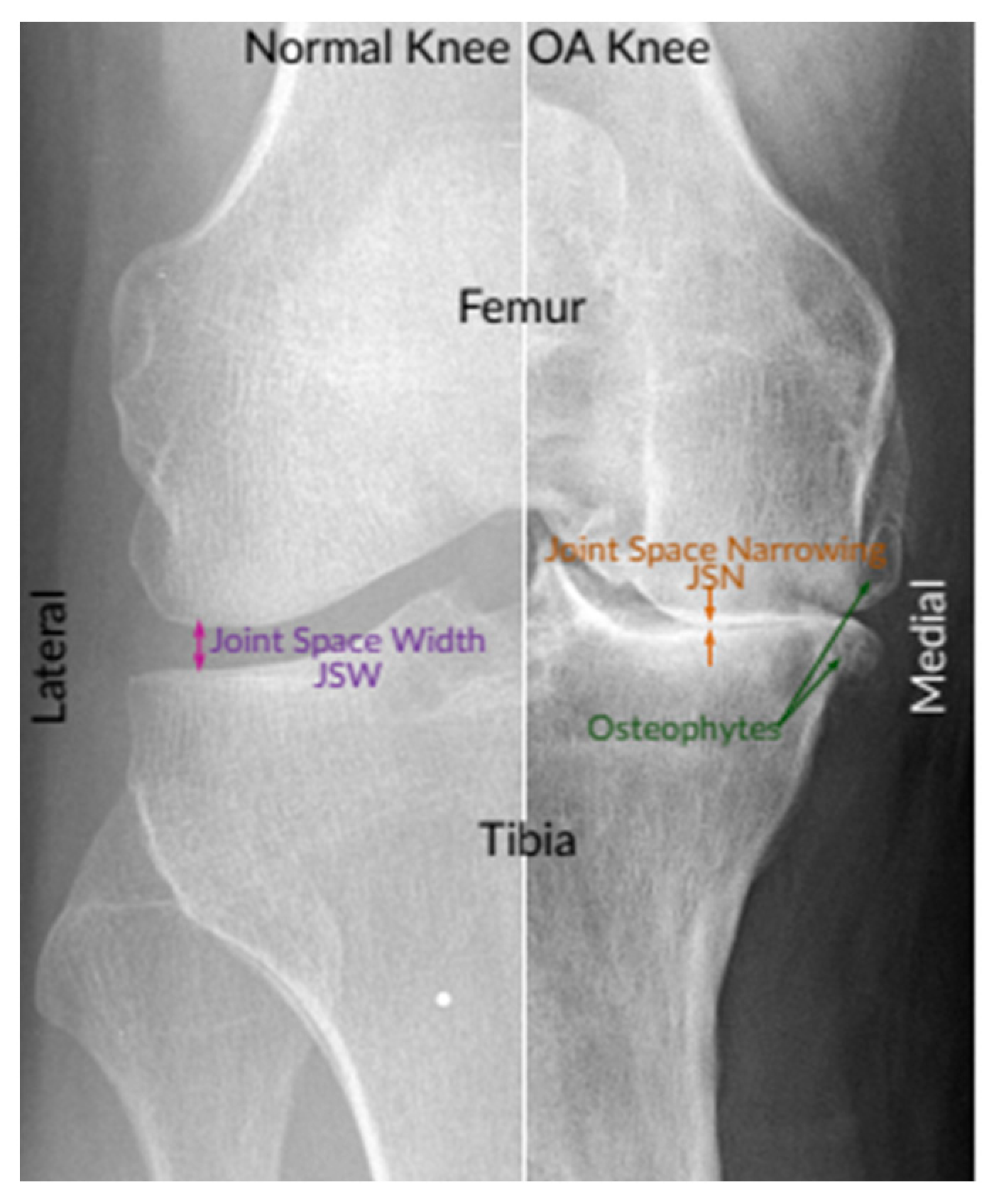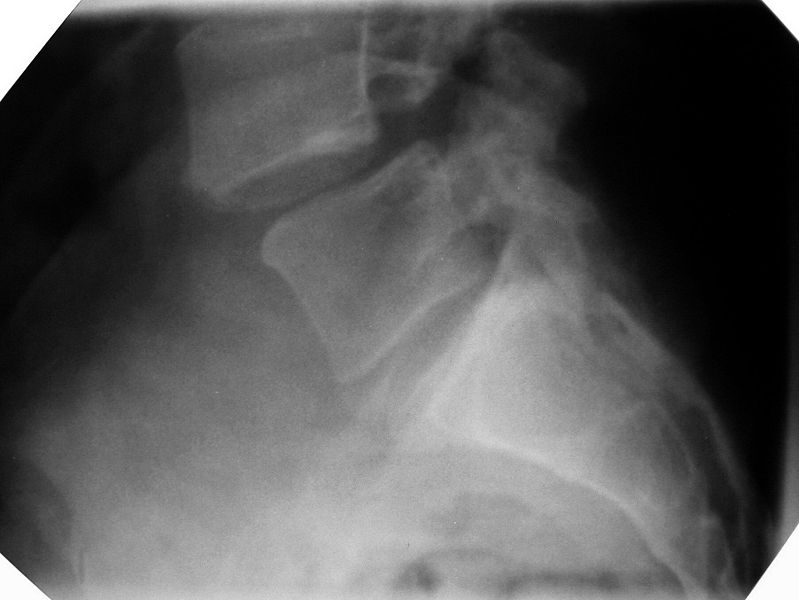It is a degenerative joint disease characterized by damage to articular cartilage, hypertrophy of bone as seen in osteophytes, subchondral bone sclerosis and thickening of the joint capsule. Risk factors include genetics, female sex, past trauma, advancing age, and obesity. It is more common after the age of 60 years. However, younger people with obesity, sedentary lifestyles, genetic cartilage defects, joint injury and malalignment can also develop osteoarthritis. Inflammatory changes in the synovium and cartilage with the production of cytokines, chemokines and other inflammatory mediators like nitric oxide and activation of proteinases leads to progressive damage of cartilage and synovium.

Osteoarthritis presents with joint pain that tends to worsen with activity, especially following a period of rest known as “gelling phenomenon”; morning stiffness lasting less than 30 minutes, joint locking and instability. It commonly affects the joints in the hands, knees, hips, and spine in an asymmetric involvement. The metacarpophalangeal joints are less likely to be involved in osteoarthritis. Swelling and deformity of proximal and distal interphalangeal joints due to osteoarthritis is called Bouchard and Heberden nodes respectively. Popliteal cyst called Baker’s cyst may occur. X ray shows joint space narrowing, osteophytes and subchondral cysts.
Gout is an inflammatory arthritis caused by the deposition of monosodium urate crystals in and around joints. It is more common in men, alcoholics, diet high in purine rich food like meat, high fructose corn syrup and in those with a family history of gout. Patients in chronic renal failure, metabolic syndrome and Lesch-Nyhan syndrome are at higher risk of gout. Medications like diuretics, cyclosporine, low-dose aspirin and niacin increase risk.
Uric acid is derived from the breakdown of purine. Hyperuricemia due to decreased excretion and/or overproduction of uric acid predisposes to the formation of monosodium urate crystals. These crystals are needle shaped and are ingested by neutrophils and macrophages, leading to secretion of pro-inflammatory cytokines such as IL 1 and TNF alpha.
The disease presents as “flare ups” of acute gout with intense pain, swelling and redness in and around joints often triggered by food, medications, trauma and illnesses. Acute gout affecting the first metatarsophalangeal joint (great toe) is called podagra. In chronic gout, tophi are produced in bone, cutaneous tissues and articular spaces. Tophi are deposits of monosodium urate crystals in soft tissue. Long term damage causes joint deformity. Renal calculi may form.
Intercritical gout is the term that refers to the asymptomatic period between the gout attacks.
Diagnosis is by clinical features, synovial fluid aspirate showing negatively birefringent, needle-shaped crystals that are yellow under parallel and blue under perpendicular light and increased neutrophil count. X ray shows “punched out” joint erosions surrounded by sclerotic changes and overhanging edges, tophi in the bones and surrounding soft tissue. Classically there is no osteopenia and joint space is preserved.
It is an inflammatory joint disease caused by the deposition of CPPD (calcium pyrophosphate dihydrate) crystals. It is seen in older age, and affects both men and women.
The knee joint is most commonly involved. Clinical features are like gout and there is chondrocalcinosis. The CPPD crystals are rhomboid in shape and are weakly positively birefringent, appearing blue on parallel polarized light. Treatment is similar to gout.
It is a chronic, systemic, autoimmune, inflammatory disorder affecting the joints and in some cases, the skin, heart, lungs and eyes. Women are more commonly involved. Autoantibodies like rheumatoid factor which is an IgM antibody against IgG, and anti- CCP (cyclic citrullinated peptide) antibodies are seen. Tissue destruction is caused by T cells, neutrophils and macrophages. Interleukins like TNF alpha, IL 1, 6 and 8 are elevated. It shows a strong association with HLA DR4. RA presents with joint pain and stiffness that lasts for more than 30 minutes, usually affecting small joints of the hands and feet (except the DIP joint), knees, cervical spine and ankle joints. Joint damage causes deformities like Swan-neck and boutonniere deformities. Subcutaneous, rheumatoid nodules are seen over extensor surfaces. Systemic involvement and inflammation of the cervical spine, heart, kidney etc occur. Patients are at risk for atlanto-axial subluxation.

Anti-CCP antibody is the most sensitive and specific test; rheumatoid factor is elevated in about 75% of patients. X rays show periarticular erosions, joint space narrowing and osteopenia. Baker’s cyst may form in the popliteal fossa, behind the knee. It is a fluid filled cyst and may rupture to resemble thrombophlebitis. Treatment of rheumatoid arthritis is with NSAIDs, steroids, methotrexate, antimalarials, leflunomide, sulfasalazine etc. Several biologics are used nowadays including etanercept, infliximab, adalimumab, anakinra, rituximab and tocilizumab.
It is an inflammatory arthritis affecting the hip joint, vertebrae, ribs, shoulders, knees, ankles and feet. Risk factors include family history, < 45 years of age, men, Crohn’s disease, ulcerative colitis, or psoriasis. Uveitis may be seen. There is a strong association with HLA B 27. It presents with lower back and/or hip pain and stiffness, pain typically gets worse during periods of rest or inactivity and gets better with moving and exercise. X ray shows bamboo spine.
Also known commonly as chondromalacia patellae or runner’s knee, is a common cause of anterior knee pain among young people, especially young women who love sports. The initial pathological change in CMP is that the cartilage becomes dull or even slightly yellowish-white, and turns soft, swollen and edematous in the early stage, followed by fragmentation, or erosion of the cartilage at the advanced stage. Presents with anterior knee pain that gets worse with squatting, climbing up or down stairs, running, prolonged sitting etc. It can lead to osteoarthritis of the knee. Examination shows retropatellar crepitus. X ray is not sensitive, MRI or arthroscopy are used for diagnosis. Management is by conservative therapy like activity restriction, physiotherapy, pain management; surgical therapy is with partial or complete patellectomy.
Disc prolapse is caused due to degenerative disease of the intervertebral disc. The intervertebral disc is composed of three layers:
Disc herniation or prolapse is bulging of the disc due to partial or complete rupture of the outer fibrous annulus. The bulging may involve anterior, posterolateral or posterior direction. Most common location is L4/5 followed by L5/S1. The most important risk factors include heavy physical labor, smoking, obesity, inappropriate flexed posture and lack of physical activity. Men between the ages of 20 and 50 are most likely to have a herniated disk. Symptoms include low back pain, sharp, shooting or burning pain that extends from the buttock down the back of one leg (sciatica), numbness or a tingling sensation and/or weakness in the leg and/or foot. The pain is decreased on standing, increased on bending and sitting. Straight leg raising or SLR test is positive in lumbar disc prolapse. Pain in the leg and low back reproduced between 30 - 70 degrees of hip flexion suggests disc herniation at L5-S1 or L4-L5. CT and MRI can reveal level and degree of herniation. X ray shows narrowed intervertebral disc spaces. Myelography localizes the site of disc herniation and the presence of root entrapment. Management of uncomplicated disc herniations is with rest, physical therapy, anti-inflammatory and analgesic medications. Persistent symptoms may benefit with corticosteroid injections. Operative therapy is with laminectomy or discectomy.
| Degree of flexion at hip | Inference |
| <30 degrees | Spondylolisthesis, gluteal abscess, inflammation of the dura mater, malingering |
| 30-70 degrees | Disc herniation at L5-S1 or L4-L5 |
| >70 degrees | Tight hamstrings or gluteus maximus, pathology of the hip or sacroiliac joints |
The cauda equina is a bunch of spinal nerves consisting of lumbar and sacral spinal nerves and the coccygeal nerve. It is shaped like a horse tail, hence the name. The cauda equina nerves collectively innervate the pelvic organs and lower limbs including internal and external anal sphincters, perineum, bladder parasympathetics to detrusor muscle in the pelvic splanchnic nerves and motor supply to the lower limb. Any lesion that compresses the cauda equina like disc herniation, spinal stenosis, spinal trauma, local ependymomas and schwannomas, metastatic tumors etc, can cause cauda equina syndrome. It presents as low back pain, sciatica, saddle anesthesia in the perineal area, lower limb paresis with hyporeflexia and bowel/ bladder incontinence. It is a surgical emergency and should be treated with immediate surgical decompression.
Both spondylolisthesis and spondylosis are degenerative disorders of the vertebra. Spondylosis is a weakening or defect in the pars interarticularis, while spondylolisthesis is anterior displacement of the vertebra which results due to spondylosis. It occurs most commonly due to repetitive stress and microtrauma and is more common in women over the age of 40 years. It occurs most commonly at L4-5 or L5-S1 vertebral levels. Symptoms include low back pain, buttock and posterior leg pain aggravated by walking and relieved by sitting and rest, signs of radiculopathy like weakness in dorsiflexion. Complications include spinal stenosis and cauda equina syndrome. AP and lateral X rays will show anterior subluxation or displacement of the vertebral body over the adjacent one. First line therapy includes NSAIDs and physical therapy, and epidural steroid injections in resistant cases. Surgical management is by decompression surgery.

Sign up for free to take 10 quiz questions on this topic